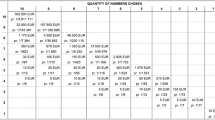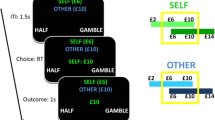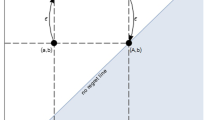Abstract
In two experiments conducted with low-income participants, we find that individuals are more likely to buy state lottery tickets when they make several purchase decisions one-at-a-time, i.e. myopically, than when they make one decision about how many tickets to purchase. These results extend earlier findings showing that “broad bracketing” of decisions encourages behavior consistent with expected value maximization. Additionally, the results suggest that the combination of myopic decision making and the “peanuts effect”—greater risk seeking for low stakes than high stakes gambles—can help explain the popularity of state lotteries.



Similar content being viewed by others
Notes
These estimates are conservative since they do not account for the fact that a substantial fraction of the households included in the data do not play the lottery. Clotfelter et al. (1999) estimates that approximately 50% of low-income households play the lottery.
See Benartzi and Thaler (1999) for a discussion of why this decision implies loss aversion, not simply risk aversion.
Results are unchanged if income is excluded from the analysis.
Since the outcome of the 5th ticket purchase is irrelevant for future decisions, this count excludes the 5th round.
References
Ackert, Lucy F., Narat Charupat, Bryan K. Church, and Richard Deaves. (2006). “An Experimental Examination of the House Money Effect in a Multi-Period Setting,” Experimental Economics 9(1), 5–16.
Benartzi, Shlomo, and Richard H. Thaler. (1995). “Myopic Loss Aversion and the Equity Premium Puzzle,” The Quarterly Journal of Economics 110(1), 73–92.
Benartzi, Shlomo, and Richard H. Thaler. (1999). “Risk Aversion or Myopia? Choices in Repeated Gambles and Retirement Investments,” Management Science 45(3), 364–381.
Bellemare, Charles, Michaela Krause, Sabina Kroger, and Chendi Zhang. (2005). “Myopic Loss Aversion: Information Feedback vs. Investment Flexibility,” Economics Letters 87(3), 319–324.
Brinner, Roger E., and Charles T. Clotfelter. (1975). “An Economic Appraisal of State Lotteries,” National Tax Journal 23(4), 395–404.
Clotfelter, Charles T., and Philip J. Cook. (1989). Selling Hope: State Lotteries in America. Cambridge: Harvard University Press.
Clotfelter, Charles T., and Philip J. Cook. (1991). “Lotteries in the Real World,” Journal of Risk and Uncertainty 4(3), 227–232.
Clotfelter, Charles T., Philip J. Cook, Julie A. Edell, and Marian Moore. (1999). “State Lotteries at the Turn of the Century.” Report to the National Gambling Impact Study Commission.
DeKay, Michael L., and Tai Gyu Kim. (2005). “When Things Don’t Add Up: The Role of Perceived Fungibility in Repeated-Play Decisions,” Psychological Science 16(9), 667–672.
Edwards, Ward. (1962). “Subjective Probabilities Inferred from Decisions,” Psychological Review 69(2), 109–135.
Gneezy, Uri, and Jan Potters. (1997). “An Experiment on Risk Taking and Evaluation Periods,” The Quarterly Journal of Economics 112(2), 631–645.
Gneezy, Uri, Arie Kapteyn, and Jan Potters. (2003). “Evaluation Periods and Asset Prices in a Market Experiment,” Journal of Finance 58(2), 821–837.
Gonzalez, Richard, and George Wu. (1999). “On the Shape of the Probability Weighting Function,” Cognitive Psychology 38(1), 129–166.
Green, Leonard, and Joel Myerson. (2004). “A Discounting Framework for Choice with Delayed and Probabilistic Rewards,” Psychological Bulletin 130(5), 769–792.
Hansen, Alicia. (1995). “The Tax Incidence of the Colorado State Lottery Instant Games,” Public Finance Quarterly 23(3), 385–399.
Hansen, Alicia. (2007). “Gambling with Tax Policy: States’ Growing Reliance on Lottery Tax Revenue,” Tax Foundation Background Paper 54.
Hansen, Alicia, Anthony D. Miyazaki, and David E. Sprott. (2000). “The Tax Incidence of Lotteries: Evidence from Five States,” The Journal of Consumer Affairs 34(2), 182–203.
Henderson, Pamela W., and Robert A. Peterson. (1992). “Mental Accounting and Categorization,” Organizational Behavior and Human Decision Processes 51(1), 92–117.
Jarvik, Murray E. (1951). “Probability Learning and a Negative Recency Effect in the Serial Anticipation of Alternative Symbols,” Journal of Experimental Psychology 41(4), 291–297.
Kahneman, Daniel, and Amos Tversky. (1979). “Prospect Theory: An Analysis of Decision under Risk,” Econometrica 47(2), 263–291.
Kahneman, Daniel, and Dan Lovallo. (1993). “Timid Choices and Bold Forecasts: A Cognitive Perspective on Risk Taking,” Management Science 39(1), 17–31.
Kearney, Melissa S. (2005a). “The Economic Winners and Losers of Legalized Gambling,” National Tax Journal 58(2), 281–302.
Kearney, Melissa S. (2005b). “State Lotteries and Consumer Behavior,” Journal of Public Economics 89(11/12), 2269–2299.
Keren, Gideon, and Willem A. Wagenaar. (1987). “Violation of Utility Theory in Unique and Repeated Gambles,” Journal of Experimental Psychology: Learning, Memory, and Cognition 13(3), 387–391.
LaFleur, Teresa, and Bruce LaFleur. (2003). LaFleur’s 2003 World Lottery Almanac. Boyds, MD: TLF Publications.
Langer, Thomas, and Martin Weber. (2001). “Prospect Theory, Mental Accounting, and Differences in Aggregated and Segregated Evaluation of Lottery Portfolios,” Management Science 47(5), 716–733.
Langer, Thomas and Martin Weber. (2003). “Does Binding of Feedback Influence Myopic Loss Aversion? An Experimental Analysis,” C.E.P.R. Discussion Paper: 4084.
Langer, Thomas, and Martin Weber. (2005). “Myopic Prospect Theory vs. Myopic Loss Aversion: How General Is the Phenomenon?,” Journal of Economic Behavior and Organization 56(1), 25–38.
León, Orfelio G., and Lola L. Lopes. (1988). “Risk Preference and Feedback,” Bulletin of the Psychonomic Society 26(4), 343–346.
Light, Ivan. (1977). “Numbers Gambling among Blacks: A Financial Institution,” American Sociological Review 42, 892–904.
Livernois, John R. (1987). “The Redistributive Effect of Lotteries: Evidence from Canada,” Public Finance Quarterly 15(3), 339–351.
Markowitz, Harry. (1952). “The Utility of Wealth,” The Journal of Political Economy 60(2), 151–158.
Prelec, Drazen. (1998). “The Probability Weighting Function,” Econometrica 66(3), 497–528.
Prelec, Drazen, and George Loewenstein. (1991). “Decision Making over Time and under Uncertainty: A Common Approach,” Management Science 37(7), 770–786.
Quiggin, John. (1982). “A Theory of Anticipated Utility,” Journal of Economic Behavior and Organization 3(4), 323–343.
Read, Daniel, George Loewenstein, and Matthew Rabin. (1999). “Choice Bracketing,” Journal of Risk and Uncertainty 19(1), 171–197.
Redelmeier, Donald A., and Amos Tversky. (1992). “On the Framing of Multiple Prospects,” Psychological Science 3(3), 191–193.
Samuelson, Paul. (1963). “Risk and Uncertainty: A Fallacy of Large Numbers,” Scientia 98, 108–113.
Spiro, Michael H. (1974). “On the Incidence of the Pennsylvania Lottery,” National Tax Journal 27(1), 57–61.
Suits, Daniel B. (1977). “Gambling Taxes: Regressivity and Revenue Potential,” National Tax Journal 30(1), 19–35.
Sylvain, Caroline, Robert Ladouceur, and Jean-Marie Boisvert. (1997). “Cognitive and Behavioral Treatment of Pathological Gambling: A Controlled Study,” Journal of Consulting and Clinical Psychology 65(5), 727–732.
Terrell, Dek. (1994). “A Test of the Gambler’s Fallacy: Evidence from Pari-mutuel Games,” Journal of Risk and Uncertainty 8(3), 309–317.
Thaler, Richard, and Eric J. Johnson. (1990). “Gambling with the House Money and Trying to Break Even: The Effects of Prior Outcomes on Risky Choice,” Management Science 36(6), 643–660.
Thaler, Richard, Amos Tversky, Daniel Kahneman, and Alan Schwartz. (1997). “The Effect of Myopia and Loss Aversion on Risk Taking: An Experimental Test,” The Quarterly Journal of Economics 112(2), 647–661.
Tversky, Amos, and Daniel Kahneman. (1992). “Advances in Prospect Theory: Cumulative Representation of Uncertainty,” Journal of Risk and Uncertainty 5(4), 297–323.
Weber, Bethany J., and Gretchen B. Chapman. (2005). “Playing for Peanuts: Why is Risk Seeking More Common for Low-Stakes Gambles?,” Organizational Behavior and Human Decision Processes 97(1), 31–46.
Wedell, Douglas H., and Ulf Böckenholt. (1994). “Contemplating Single versus Multiple Encounters of a Risky Prospect,” American Journal of Psychology 107(4), 499–518.
Wu, George, and Richard Gonzalez. (1998). “Common Consequence Conditions in Decision Making under Risk,” Journal of Risk and Uncertainty 16(1), 115–139.
Acknowledgement
We thank the editor and an anonymous referee for extensive helpful comments. We also thank research assistants Ryan Menefee and Sarat Mikkilineni. This research was funded by the Russell Sage Foundation Small Grants in Behavioral Economics Program.
Author information
Authors and Affiliations
Corresponding author
Rights and permissions
About this article
Cite this article
Haisley, E., Mostafa, R. & Loewenstein, G. Myopic risk-seeking: The impact of narrow decision bracketing on lottery play. J Risk Uncertain 37, 57–75 (2008). https://doi.org/10.1007/s11166-008-9041-1
Published:
Issue Date:
DOI: https://doi.org/10.1007/s11166-008-9041-1




